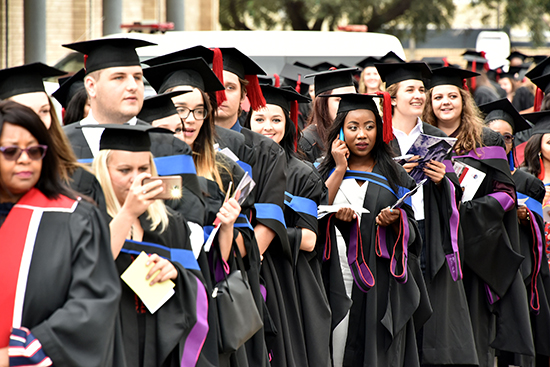Latest News Archive
Please select Category, Year, and then Month to display items
14 June 2018
Photo Charl Devenish
 Graduates will be celebrating their accomplishments at the June Graduation ceremonies.
Graduates will be celebrating their accomplishments at the June Graduation ceremonies.
June 2018 graduates from the University of the Free State (UFS) Bloemfontein Campus are beginning to prepare for their upcoming graduations. The ceremonies are scheduled to take place at the Callie Human Centre from Wednesday 27 June until Friday 29 June 2018.
The UFS plans to document and highlight the special moments that graduates encounter at this time. A daily update accompanied by photos will be available on the UFS website.
Visit the UFS graduation ceremonies page for more information on the upcoming events. Graduates and students are free to familiarise themselves with the Graduation Guide Booklet which stipulates the necessary information for students to note during the graduation processions.
The Graduate Career Guide is also of vital importance as it equips graduates with fundamental knowledge and practical advice about preparing for the world of work.
A livestream link will be provided for the different graduation processions closer towards the time.
Graduation ceremonies for the different faculties take place on the following dates:
Wednesday 27 June 2018
09:00 School of Financial Planning Law
All qualifications.
Programme
14:30 School of Open and Distance Learning
Certificates
Programme
Thursday 28 June 2018
09:00 All faculties except for Natural and Agricultural Sciences
Master’s and doctoral degrees
Programme
14:30 Faculty of Natural and Agricultural Sciences
Master’s and doctoral degrees
Programme
Friday 29 June 2018
09:00 NO SESSION
14:30 School of Open and Distance Learning
Diplomas
Programme
Prof Tredoux turns theories regarding the formation of metals on its head
2013-09-17
|
 |
|
Prof Marian Tredoux
17 September 2013 |
The latest research conducted by Prof Marian Tredoux of the Department of Geology, in collaboration with her research assistant Bianca Kennedy and their colleagues in Germany, placed established theories regarding how minerals of the platinum-group of elements are formed, under close scrutiny.
The article on this research of which Prof Tredoux is a co-author – ‘Noble metal nanoclusters and nanoparticles precede mineral formation in magmatic sulphide melts’ – was published in Nature Communications on 6 September 2013. It is an online journal for research of the highest quality in the fields of biological, physical and chemical sciences.
This study found that atoms of platinum and arsenic create nanoclusters, long before the mineral sperrylite can crystallise. Thus, the platinum does not occur as a primary sulphur compound. The research was conducted at the Steinmann Institute of the University of Bonn, Germany, as well as here in Bloemfontein.
Monetary support from Inkaba yeAfrica – a German-South African multidisciplinary and intercultural Earth Science collaborative of the National Research Foundation (NRF) – made this research possible. Studies are now also being conducted on other metals in the precious metal group, specifically palladium, rhodium and ruthenium.
The discovery of the nanoclusters and the combination with arsenic can have far-reaching consequences for the platinum mine industry, if it can be utilised to recover a greater amount of platinum ore and therefore less wastage ending up in mine dumps. This will signify optimal mining of a scarce and valuable metal, one of South Africa’s most important export products.
For Prof Tredoux, the research results also prove thoughts she already had some twenty years ago around the forming of platinum minerals. “Researchers laughed in my face, but the evidence had to wait for the development of technology to prove it.” Young researchers were very excited at recent congresses about the findings, since the new models can bring new insights.
“Chemistry researchers have been talking about platinum element clusters in watery environments for quite a while, but it was thought that these would not appear in magmas (molten rock) due to the high temperatures (>1 000 degrees celsius).”
Prof Tredoux has already delivered lectures at congresses in Scotland, Hungary, Sweden and Italy on this research.
Read the article at: http://www.nature.com/ncomms/2013/130906/ncomms3405/full/ncomms3405.html